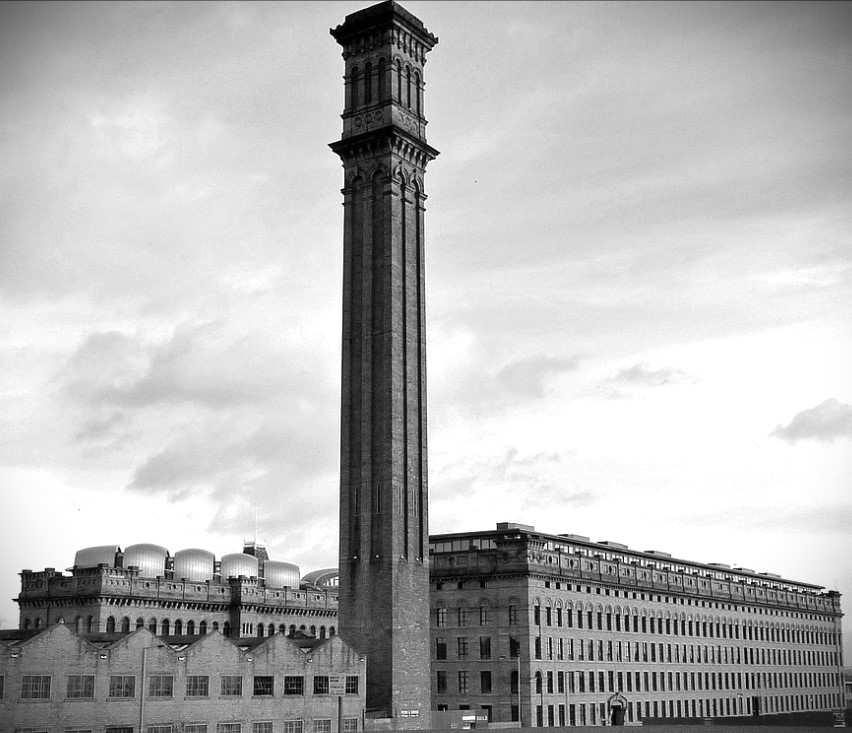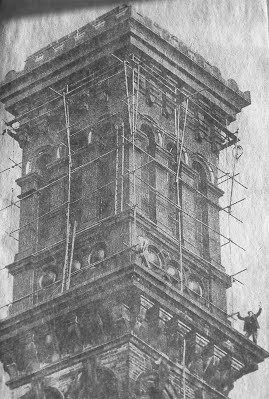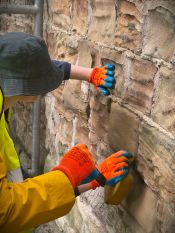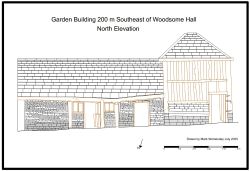Analysis of Building Mortars from the Famous Lister Mill Chimney in Bradford
M. Womersleys has recently completed a mortar analysis of several samples collected from the iconic chimney at Lister Mills. Many of these samples originated from later repointing efforts, which involved a combination of lime and earlier Ordinary Portland Cement. However, one sample from the beds halfway up this 76-meter chimney exemplifies the mortars typically used during the mid-Victorian period.

The mortar analysis of this sample indicates that the binding matrix was likely composed of 1 part feebly hydraulic lime mixed with 1 part crushed clinker ash, along with a small quantity of brick fragments and quartz. The fine ash particles in the mix reacted with calcium hydroxide to form calcium silicate hydrate, contributing to the hydraulic binder content within the mortar.
As is standard practice, M. Womersleys recommends a suitable repointing mix compatible with the stone and the original bedding mortar. Unfortunately, sourcing suitable ash in large quantities to replicate the original mix has become challenging. A proposed alternative mix includes 1 part Ionic Old White NHL3.5, 1 part Nosterfield Sand, 1 part Leighton Buzzard sand, and ¼ part coarse clinker ash, with an addition of 500 grams of black iron oxide pigment for every 20 litres of mortar.
Lister Mills, also known as Manningham Mills, was the largest silk factory in the world. It was in the Manningham district of Bradford, in West Yorkshire. Constructed by Samuel Cunliffe Lister to replace the original Manningham Mills, which succumbed to a fire in 1871, this iconic mill is recognised as a Grade II* listed building, showcasing the Italianate style of Victorian architecture.
Upon its completion in 1873, Lister Mills became the largest textile mill in northern England, featuring a floor area of 27 acres (11 ha). Its distinctive shape has since remained a prominent aspect of the Bradford skyline. The chimney from which the lime mortar was analysed, known as "Lister’s Pride," rises 249 feet (76 m) high and is externally 22 feet square at the base, with an internal width of 10-11 feet. Although not the tallest chimney in Bradford, its commanding position on high ground makes it visible from most parts of the city. Inspired by the Campanile in Venice, the design reflects an element of Victorian monumentality where form did not simply follow function. The chimney is often regarded as the finest piece of Bradford’s city architecture.
The construction of the chimney was completed at £10,000 by the builders J & W Beanland, a well-known Bradford contracting firm responsible for notable projects such as the Leeds Infirmary and the Wool Exchange. The chimney features two elaborate cornices, one at 190 feet and another at the top. While the visible material is a beautiful honey-coloured sandstone masonry, it is believed there was an inner skin of brickwork, with fire-resistant brick lining the lower portion.
Historically, the completion of the chimney garnered local attention, with its dimensions published in newspapers. Notably, W.H. Watson, who later became the mill’s manager, recalled an adventure in his youth where he scaled the chimney shaft, reaching the first cornice before deciding to descend, demonstrating remarkable courage for the time.
On the day of the chimney’s official completion, a lunch party reportedly took place at the top, attended by Samuel Cunliffe Lister, the architects Messrs. Andrews & Pepper, William Beanland, and project manager Francis Lepper. The occasion included a bottle of champagne broken in a baptismal ritual and concluded with speeches and a "champagne luncheon," reflecting the energy and spirit of the Victorian era.

At its peak, Lister Mills employed around 11,000 men, women, and children, producing high-quality textiles such as velvet and silk. The mill supplied 1,000 yards (910 m) of velvet for King George V's coronation and provided new velvet curtains for President Ford's White House in 1976. During World War II, Lister Mills produced an impressive 1,330 miles (2,140 km) of genuine parachute silk, 284 miles (457 km) of flame-proof wool, 50 miles (80 km) of khaki battledress, and 4,430 miles (7,130 km) of parachute cord.
A significant strike at the mill in 1890-91 played a pivotal role in the establishment of the Independent Labour Party, which later contributed to the foundation of the modern-day Labour Party.
The 1980s marked a significant decline for the Lister business due to intense foreign competition and shifts in textile trends, including a rise in synthetic fibres. The mills ultimately closed in 1999. Being a prominent structure, Lister Mills attracted considerable attention, leading to various regeneration proposals, though the sheer size of the buildings posed challenges.
In 2000, property regeneration company Urban Splash acquired Lister Mills from the administrators Ernst and Young, with plans to renovate the silk warehouse, estimated to cost around £100 million. Renovation efforts began in 2003, with formal construction starting in September 2004. The project created 131 new homes and three ground-floor commercial units within the large buildings. Although construction was completed in 2006, a substantial portion of the site remained unmaintained.
The second phase involved regenerating the largest building on the site, the velvet mill, where the existing roof was replaced with a glass and steel structure. This upgrade created two-story apartments and additional ground-floor commercial spaces while preserving the mill's original architectural features, designed by David Morley Architects. The new homes were put on sale in early 2007.
Related Articles

The steps members of the Waterton’s Wall restoration team, with support from Mark Womersley, have been following to consolidate, conserve and repair this historic wall that represents the successful efforts of Charles Waterton to preserve the wildlife that lived on his estate near Wakefield in West Yorkshire.
1. Fill deep voids behind the wall’s facing stones with deep pointing work. The works involve …

Mark spent a day recording a historic timber-framed garden building at Woodsome Hall
Mark Womersley, as part of his voluntary work with the Yorkshire Vernacular Buildings Study Group, spent…

M Womersleys were delighted to offer a day of tutoring to those who attended the Wentworth Woodhouse Working Party
M Womersleys were delighted to offer a day of tutoring to those who attended the Wentworth Woodhouse…